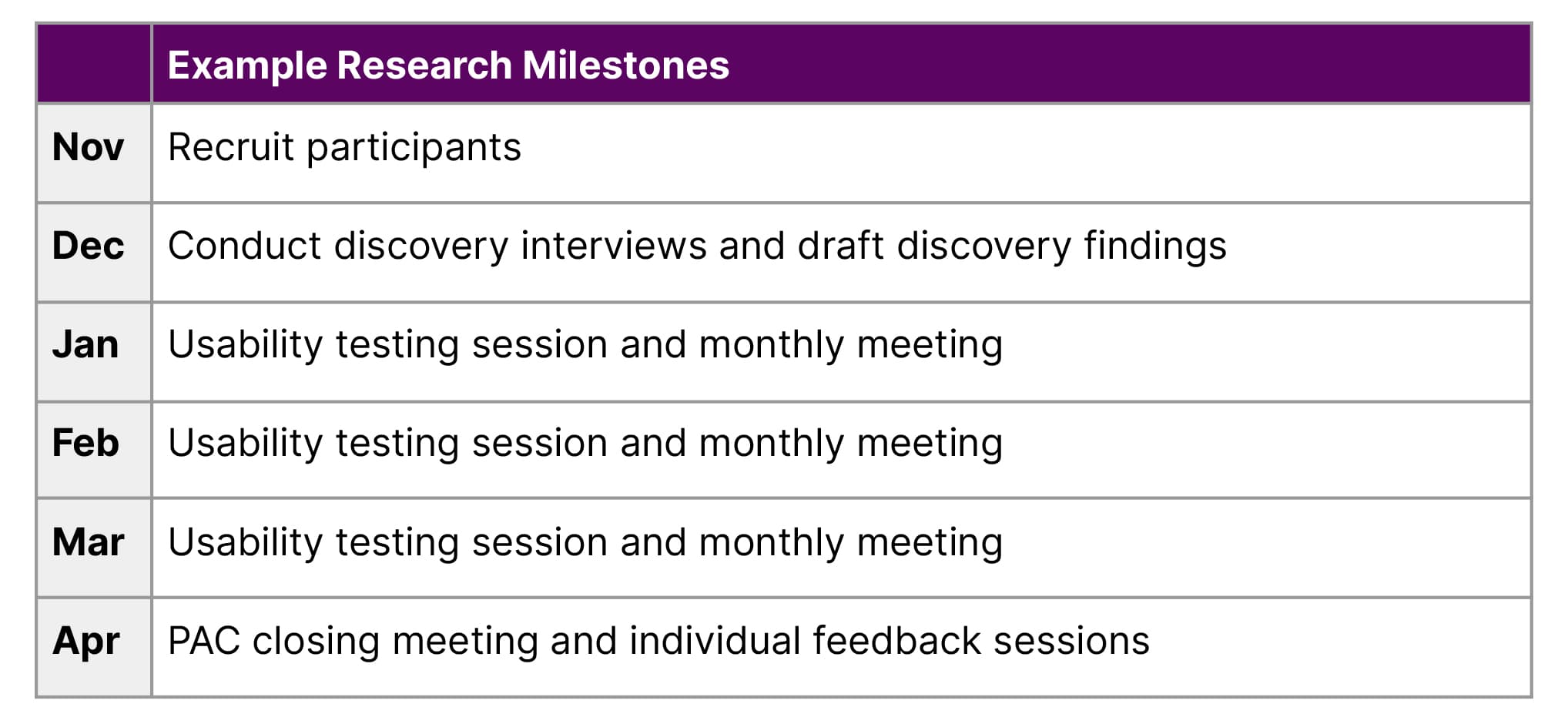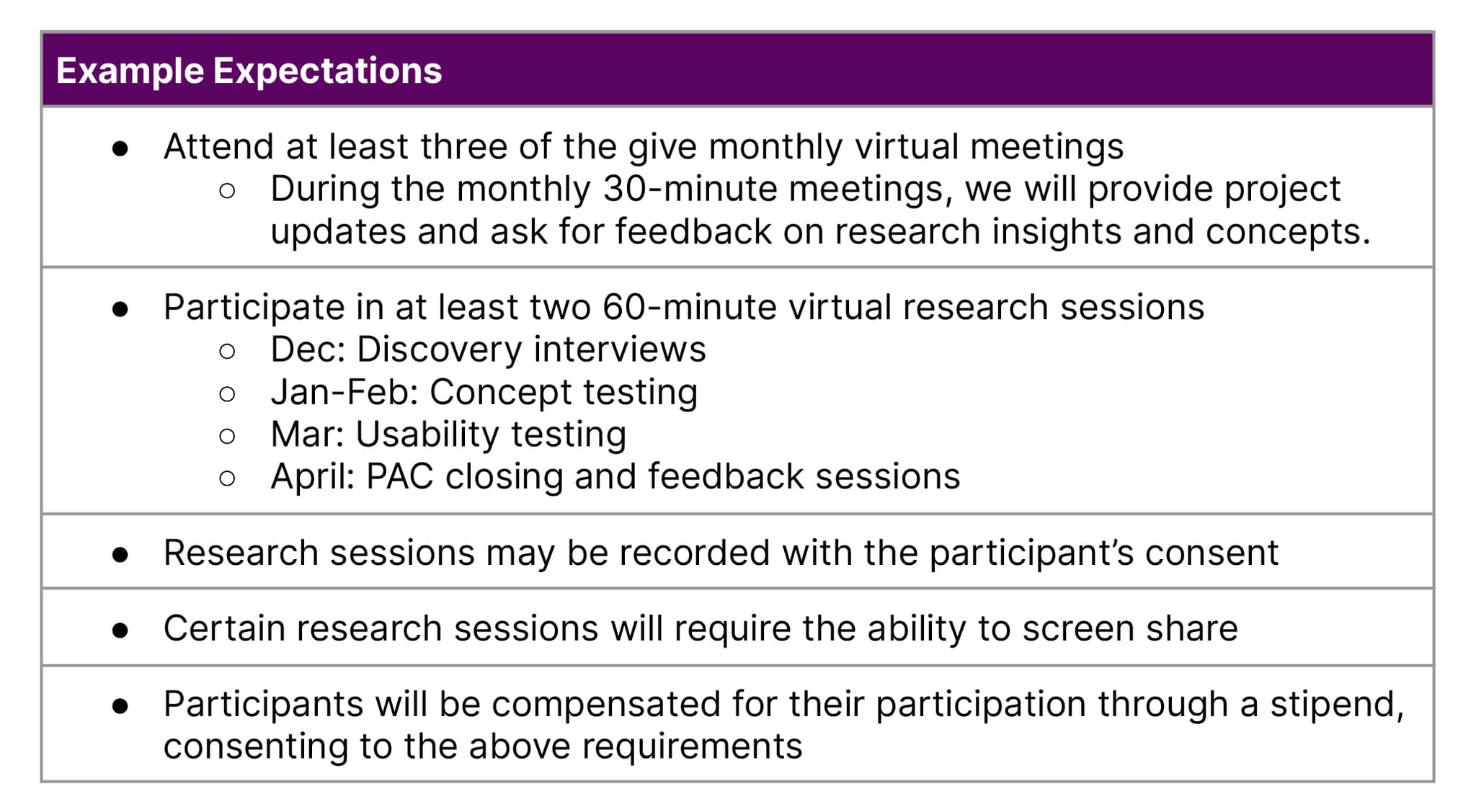When designing public services, it’s important to conduct research with people who will be directly impacted by the product or service. Engaging a diverse pool of end users throughout the design process can ensure that their needs and perspectives are integrated into decisions. One way to do this is by establishing a participant advisory council (PAC).
A PAC is a group of program participants that convenes to engage in user research sessions and advise on program improvements. PACs can speed up the research recruitment process and facilitate deeper, more meaningful relationships and feedback from participants.
Last year, Nava formed its first-ever PAC as part of our initiative to help Montana’s Special Supplemental Nutrition Program for Women, Infants, and Children (WIC) program design a new recertification portal, which will reduce the burden of the six-month/annual recertification process on WIC participants and staff.
Our council was made up of 12 WIC participants who attended monthly meetings and participated in research activities to help our team ensure that the portal meets participants’ needs. Leveraging what we learned from this experience, this toolkit outlines the necessary steps to form a PAC, including planning a structure for the council, recruiting participants, and other logistics. This toolkit is broadly applicable to many types of programs and projects, not just projects focused on WIC.
This toolkit can help you:
- Understand the steps to setting up a PAC
- Provide the tools and templates you’ll need to set up and conduct recruitment for a PAC
Note: This toolkit is focused on the process of setting up a PAC and will not cover long-term PAC operations and maintenance, which will be discussed in a future post.
Why form a PAC?
A PAC can provide a consistent pool of participants for user research studies, and it can speed up the user research recruitment process because teams only recruit for a PAC once. This makes the research process quicker, less expensive, and more responsive to a project’s research needs.
Forming a PAC can also address some of the problems associated with user research. In the typical user research process, research sessions are one-offs, and the relationship with a participant ends after the interview is over. This can make user research feel extractive, especially for vulnerable populations. On the other hand, the PAC approach centers on building relationships with participants. By continuously sharing research with participants and engaging them, a PAC can make participants feel more heard and involved. Furthermore, researchers become familiar with PAC members’ unique circumstances, allowing them to tailor their research questions accordingly and yield deeper research insights.
Finally, PACs allow for participant input without committing to a full research engagement. For example, Nava’s WIC PAC used their monthly meetings to get feedback on early-stage concepts. This helped the team understand if and where they would need to do deeper research with PAC members later on.
Is a PAC right for my project?
Not every project is a good fit for the PAC model. Here are some things you might consider before starting a PAC:
Project length: PACs are designed to have regularly scheduled meetings with participants over time. If your project is short-term, more traditional research methods might be a better fit.
Research needs: PACs are designed to engage the same participants over time. If your project only requires research on a few occasions, or if it requires new or different types of participants for each round of research, the PAC model might not be the right fit.
Budget: Participating in a PAC can be a longer-term commitment, and it's important to compensate participants accordingly. If your team doesn’t have the budget for this, it may be better to scope smaller-scale research studies that will use less participant time.
Point person: Running a PAC requires a dedicated point person who will be responsible for communicating with PAC members and facilitating meetings. If your team doesn’t have the capacity to designate a single point person, the PAC model might not be the right fit.
Steps to form a PAC
Planning
Building a PAC schedule
When forming a PAC, start by reviewing your project's goals and roadmap. What type of research activities and checkpoints will be beneficial for your project? Based on the timeline for the project, when do these activities need to occur? Using this information, map out a structure and schedule for your project’s PAC.

For more information on usability testing, reference our toolkits on planning and conducting a usability test.
Setting guidelines for participation
In order to make participating in the PAC feel manageable for potential participants, define guidelines for the length of activities and set expectations around which activities will be optional versus required. Decide how consent and privacy will be handled in both group and individual sessions, and be transparent about these expectations during recruitment.

Determine a point person
Since a key component of the PAC model is establishing relationships between researchers and participants, it’s important to designate a point person who will be responsible for communicating with PAC members and facilitating PAC meetings. You can set up a secondary support person, but avoid rotating in too many researchers, since it could become confusing or disruptive for PAC members.
Budget for compensation
PAC members should be compensated for their participation. We recommend compensating participants at least $60 for a 60 minute call to help ensure that participants will be able to give you their time. Applying this base rate to the number of engagements that PAC participants are required to attend will yield the total compensation for each participant.

Determine a compensation strategy
Before recruitment can begin, determine the cadence and type of payment participants will receive. For the WIC PAC, participants received a $300 stipend, which was delivered in three installments of $100 gift cards sent by email. Compensating participants in three installments at the beginning, middle, and end of the PAC, as opposed to paying participants after their participation in each PAC activity, made gift card management easier since everyone was paid the same amount at the same time. Compensating participants in installments also helps maintain the budget in the event that a participant drops out and another PAC member needs to be recruited.
Recruitment
Determine who to recruit
Your PAC should reflect the diverse community of people who will use your product or service. For Nava’s WIC PAC, the populations we aimed to recruit included:
Fathers
Foster parents
Grandparents and other guardians
Breastfeeding people
Non-breastfeeding people
Pregnant people
People who live in urban and rural areas
People who speak English as a second language
Tribal participants
People with physical disabilities.
If you’re collaborating with a partner agency like we did with WIC, be sure to include them in conversations about recruitment. Partner agencies can assist in defining and sourcing the right participants for your PAC .
Design recruitment materials
Now it’s time to recruit participants, which will likely require a variety of outreach efforts and processes. Some of the tools you may need to conduct recruitment are:
The flier, social media content, text message, and email templates above direct participants to an interest form, which can be used to ensure eligibility for participation and collect responses from interested participants so that researchers can schedule intake calls. These templates are easily downloadable and usable for your project.
Partner with agency staff
Montana WIC staff supported recruitment for our PAC by referring potential participants to our interest form. If you’re working with a partner agency, their staff may be able to:
Refer you to potential participants for the PAC
Share your recruitment materials with potential participants
Provide potential participants’ contact information for you to share outreach materials
Intake
Schedule intake calls
Once you receive responses from the interest form, schedule intake calls with respondents using this email template. Depending on how many responses you receive, your team may need to be selective about who to schedule intake calls with.
Conduct intake calls
Conduct 15-minute intake calls with each respondent. Use this script to explain what participating in the PAC would look like, the stipend amount, the payment schedule, and to answer any questions. This call is also an opportunity to share what it's like to participate in a user research study and explain your approach to privacy and consent. Make sure that you conduct intake discussions over a phone call instead of by email to ensure that participants fully understand expectations and have an opportunity to ask questions.
Collect participant agreement forms
At the end of these calls, share a PAC agreement form with people who expressed interest in joining the PAC. This form includes information about compensation and expectations for PAC members. Once the participants sign the form, they are formally considered members of the PAC.
Lessons learned: Best practices for working with a PAC
Overall, our first PAC was a success. The PAC members were very engaged, which means we received consistent feedback on the content and usability of our website as well as on the design of the overall pilot process. Closing interviews with PAC members also highlighted that this model can improve trust with government agencies. Several PAC members said that being part of the council showed them that WIC cared about their experience and was striving to make improvements. These closing interviews, as well as our own reflections, did reveal some lessons learned and iterations we plan to make if we run another PAC.
Below, we outline recommended best practices for running a PAC, based on the lessons we learned from operating ours. It’s important to note that for this project, we conducted all of the recruitment, management, and research with PAC members remotely. We developed these recommendations within the context of facilitating the PAC through online and digital tools.
Offer meeting times that are after working hours
In order to accommodate the PAC members’ schedules, we offered two time slots for each monthly meeting. Both slots, however, were during lunch time. In the future, we plan to continue offering two time slots per month, but one of those time slots should be in the evening to accommodate PAC members that work during the day.
Plan ahead for participant drop-out
While participant drop-out isn’t desirable, sometimes it’s unavoidable. You can prepare your PAC for potential drop-out by:
Letting participants know during intake interviews whom they should contact if they need to drop-out.
Compensating participants in installments so that if one participant drops off, you can recruit another while staying within the budget.
Starting the PAC with 1-2 more participants than your target. If 1-2 participants drop out, you don’t need to do additional recruitment.
Provide guidance on using the stipend
We opted to use digital Vanilla gift cards, which work similar to a Visa debit card. Some participants expressed confusion over how to use these cards when shopping in-person, how to check the balance of their card, and how to prevent any leftover balance. We plan to provide a more detailed guide in the future so PAC members can easily use and maximize these stipends.
Develop protocols for requests to help access benefits
It’s important to work with agency staff to set a protocol for how to handle questions from PAC members about their benefits. Given the relationship built between participants and researchers in a PAC, it’s not uncommon for PAC members to have questions about accessing their benefits that fall outside a researcher’s knowledge or purview. In our case, when these questions arose, researchers in the PAC either reached out to WIC staff and then followed up with PAC participants or connected PAC participants directly to WIC staff who could help with their inquiry.
Assess if monthly meeting content might bias future research studies
Since PACs are longer-term, repeated engagements, you must figure out how to share updates at monthly meetings without biasing participants on future research studies. For example, during one monthly meeting, we shared in-progress content to get feedback on language. After this meeting, we made changes to the content on a key page based on that feedback. However, we were still in the middle of testing early versions of the experience that referenced the original content. We realized we should wait to work with all participants on the updated content until after we had completed usability testing so as not to bias them.
Get in touch
If you use this guide, we’d love to hear from you. To share questions or feedback, email us at hello@navapbc.com.
Special thanks to Juliahna Green who contributed to this article.
Written by

Principal Designer and Researcher

Senior Designer/Researcher
